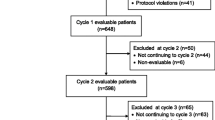Abstract
Objective
It is a current hypothesis that chemotherapy-induced nausea and vomiting (CINV) may ultimately impede the clinical success of cancer treatments by hindering patients’ adherence to the optimal treatment schedule. The aim of this study is to examine clinical trial data retrospectively for possible evidence of such a detrimental impact of CINV.
Patients and methods
Data from three recent European Organization for Research and Treatment of Cancer (EORTC) trials of highly emetogenic cisplatin-based chemotherapy in diverse patient populations were analyzed retrospectively for incidence and possible impact of CINV. Data on the incidence of emesis are presented as simple descriptive analyses, while the hypothetical impact of CINV on clinical outcomes and on the patients’ length of hospital stays is analyzed by means of multivariate regression analysis techniques to control for confounding variables.
Main results
Between 42 and 59% of the patients in the trials experienced at least one episode of nausea of NCIC grade 2 or worse, while the incidence of vomiting of similar grade was between 31 and 58%. Only in one of the trials could the determinants of the adherence to protocol therapy be assessed, statistically significant variables were the severity of emesis (p<0.0001) and other toxicities combined (p<0.019). In turn, a Cox regression showed adherence to protocol therapy and other toxicities as the only statistically significant determinants of overall survival.
Conclusions
This study has shown a discernible detrimental impact of CINV on patients’ adherence to protocol therapy and, indirectly, on survival in one of the three trials examined. Further studies are required to substantiate this finding.


Similar content being viewed by others
Notes
The p values presented for the statistical tests are without correction for multiple testing, which makes it likely that some of the statistically significant associations found occur simply by chance.
This procedure had not yet been introduced at the time of initiation of the other trials, in the course of which only the occurrence or not of a SAE was recorded.
But statistical tests of this become meaningless because only 12 patients went off protocol for these reasons.
Patients were always hospitalized for a minimum of one night, when given the cisplatin-based regimens of chemotherapy, while the regimen without cisplatin was mostly given on an outpatient basis.
According to the subjective assessment of the clinician recording the patient’s data.
References
Anderson JR, Cain KC, Gelber RD (1983) Analysis of survival by tumor response. J Clin Oncol 1:710–719
Ballatori E, Roila F (2003) Impact of nausea and vomiting on quality of life in cancer patients during chemotherapy. Health Qual Life Outcomes 1:46
De Wit R, Roberts T, Wilkinson P et al (2001) Equivalence of three or four cycles of bleomycine, etoposide and cisplatin chemotherapy and of a 3- or 5-day schedule in good-prognosis germ cell cancer: a randomized study of the European Organization for Research and Treatment of Cancer Genitourinary Tract Cancer Cooperative Group and The Medical Research Council. J Clin Oncol 19:1629–1640
Kris MK (2003) Why do we need another antiemetic? Just ask. (editorial) J Clin Oncol 21(22):4077–4080
Piccart MJ, Bertelsen K, James K, Cassidy J, Mangioni C, Simonsen E et al (2000) Randomized intergroup trial of cisplatin–paclitaxel versus cisplatin–cyclophosphamide in women with advanced epithelial ovarian cancer: three year results. J Natl Cancer Inst 92:699–708
Schnell FM (2003) Chemotherapy-induced nausea and vomiting: the importance of acute antiemetic control. The Oncologist 8:187–198
Smit EF, van Meerbeeck PAM, Lianes P, Debruyne C, Legrand C, Schramel F, Smit H, Gaafaar R, Biesma B, Manegold C, Neymark N, Giaccone G (2003) Three-arm randomized study of two cisplatin-based regimens and paclitaxel plus gemcitabine in advanced non-small cell lung cancer: a phase III trial of the European Organization for Research and Treatment of Cancer Lung Cancer Group—EORTC 08975. J Clin Oncol 21:3909–3917
Uyl-de-Groot CA, Wait S, Buijt I (2000) Economics and health-related quality of life in antiemetic therapy: recommendations for trial design. Eur J Cancer 36:1522–1535
Author information
Authors and Affiliations
Corresponding author
Rights and permissions
About this article
Cite this article
Neymark, N., Crott, R. Impact of emesis on clinical and economic outcomes of cancer therapy with highly emetogenic chemotherapy regimens: a retrospective analysis of three clinical trials. Support Care Cancer 13, 812–818 (2005). https://doi.org/10.1007/s00520-005-0803-x
Received:
Accepted:
Published:
Issue Date:
DOI: https://doi.org/10.1007/s00520-005-0803-x




